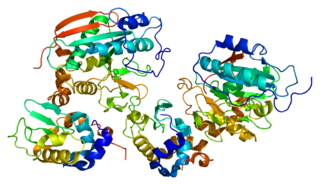ST3 beta-galactoside alpha-2,3-sialyltransferase 3, also known as ST3GAL3, is a protein which in humans is encoded by the ST3GAL3 gene. [5] [6]
ST3 beta-galactoside alpha-2,3-sialyltransferase 3, also known as ST3GAL3, is a protein which in humans is encoded by the ST3GAL3 gene. [5] [6]
The protein encoded by this gene is a type II membrane protein that catalyzes the transfer of sialic acid from CMP-sialic acid to galactose-containing substrates. The encoded protein is normally found in the Golgi apparatus but can be proteolytically processed to a soluble form. This protein is a member of glycosyltransferase family 29. Multiple transcript variants encoding several different isoforms have been found for this gene. [6]
Mutations in the ST3GAL3 gene was recently shown to be the cause of autosomal recessive mental retardation 12. Since the mutations disrupt a glycosylation pathway, this disorder may be considered a congenital disorder of glycosylation.

Sialyltransferases are enzymes that transfer sialic acid to nascent oligosaccharide. Each sialyltransferase is specific for a particular sugar substrate. Sialyltransferases add sialic acid to the terminal portions of the sialylated glycolipids (gangliosides) or to the N- or O-linked sugar chains of glycoproteins.

Beta-1,4-galactosyltransferase 1 is an enzyme that in humans is encoded by the B4GALT1 gene.

Alpha-N-acetylneuraminide alpha-2,8-sialyltransferase is an enzyme that in humans is encoded by the ST8SIA1 gene.

Lactosylceramide alpha-2,3-sialyltransferase is an enzyme that in humans is encoded by the ST3GAL5 gene.

Polypeptide N-acetylgalactosaminyltransferase 2 is an enzyme that in humans is encoded by the GALNT2 gene.

CMP-N-acetylneuraminate-beta-galactosamide-alpha-2,3-sialyltransferase is an enzyme that in humans is encoded by the ST3GAL4 gene.

Beta-1,4-galactosyltransferase 7 also known as galactosyltransferase I is an enzyme that in humans is encoded by the B4GALT7 gene. Galactosyltransferase I catalyzes the synthesis of the glycosaminoglycan-protein linkage in proteoglycans. Proteoglycans in turn are structural components of the extracellular matrix that is found between cells in connective tissues.

ST6 (alpha-N-acetyl-neuraminyl-2,3-beta-galactosyl-1,3)-N-acetylgalactosaminide alpha-2,6-sialyltransferase 4, also known as sialyltransferase 3C (SIAT3-C) or sialyltransferase 7D (SIAT7-D) is a sialyltransferase enzyme that in humans is encoded by the ST6GALNAC4 gene.

Alpha-mannosidase 2 is an enzyme that in humans is encoded by the MAN2A1 gene.

Beta-1,4-galactosyltransferase 2 is an enzyme that in humans is encoded by the B4GALT2 gene.

Beta-1,3-galactosyltransferase 5 is an enzyme that in humans is encoded by the B3GALT5 gene.

Alpha-1,3-mannosyl-glycoprotein 4-beta-N-acetylglucosaminyltransferase B is an enzyme that in humans is encoded by the MGAT4B gene.

Mannosyl-oligosaccharide 1,2-alpha-mannosidase IA is an enzyme that in humans is encoded by the MAN1A1 gene.

Alpha-N-acetylgalactosaminide alpha-2,6-sialyltransferase 1 is an enzyme that in humans is encoded by the ST6GALNAC1 gene. This enzyme adds a N-Acetylneuraminic acid to an O-linked N-Acetylgalactosamine (GalNAc) on a peptide/proteins with an α2-6 linkage to produce the sialyl-Tn antigen. It has been shown that the enzyme prefers Thr over Ser containing GalNAc residues.

Beta-1,4-galactosyltransferase 4 is an enzyme that in humans is encoded by the B4GALT4 gene.

Alpha-1,6-mannosylglycoprotein 6-beta-N-acetylglucosaminyltransferase B is an enzyme that in humans is encoded by the MGAT5B gene.

Alpha-N-acetylgalactosaminide alpha-2,6-sialyltransferase 6 is an enzyme that in humans is encoded by the ST6GALNAC6 gene.

Beta-1,4-galactosyltransferase 3 is an enzyme that in humans is encoded by the B4GALT3 gene.

Beta-1,3-galactosyltransferase 4 is an enzyme that in humans is encoded by the B3GALT4 gene.

Alpha-1,3-mannosyl-glycoprotein 4-beta-N-acetylglucosaminyltransferase A is a type II membrane protein and an enzyme – particularly a glycosyltransferase – that, in addition to the related isoenzyme B (MGAT4B), takes part in the transfer of N-acetylglucosamine (GlcNAc) to the core mannose residues of N-linked glycans in Golgi apparatus. Therefore, it is essential for the formation of tri- and tetra-antennary sugar chains. Furthermore, it is involved in glucose transport by mediating SLC2A2/GLUT2 glycosylation with controlling cell-surface expression of SLC2A2 in pancreatic beta cells and, as it is suggested, in regulating the availability of serum glycoproteins, oncogenesis, and differentiation.